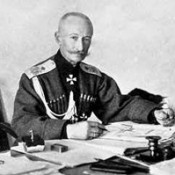
Anniversary of the Brusilov Offensive
On May 22 (June 4) 1916 during the World War I was launched one of the largest offensive operations of the Russian Army on the Southwestern front, which enabled to undertake a strategic breakthrough of the enemy’s front — called “the Brusilov Offensive”.
The general plan of the Russian Army’s operations for the summer campaign of 1916 was developed by the High Command (Stavka) and depended on strategic plans, taken by the Allies in March 1916 in Chantilly. A decisive offensive, according to them, could have been launched only to the north of Polesia, that is by armies of the Northern and Western fronts. The Southwestern front was to adopt a defensive strategy. However at the Military Council, which took place in April 1916 in Mogilev, the commander of the Southwestern front, General Alexei A. Brusilov, insisted that his front participated in the attack as well. In May, after heavy defeats of the Italian Army in the province of Trento (Trentino), the Allies addressed Russia with a request to speed up the beginning of the offensive.
The front of the General Brusilov consisted of four armies: 8th Army (commander — General A. M. Kaledin); 11th Army (commander — General V. V. Sakharov); 7th Army (commander — General D. G. Shcherbachev); 9th Army (commander — General P. A. Lechitskiy). The latter, due to illness, was on the temporary basis replaced by General A. M. Krylov.
The Southwestern front has at its disposal 40 infantry and 15 cavalry divisions, 1770 light and 168 heavy machine guns, 100 airplanes. To counteract forces of the Southwestern front the enemy amassed 39 infantry and 10 cavalry divisions, and about 2,000 guns. The Russian Army outnumbered the enemy’s by the manpower and light artillery; however the enemy’s heavy artillery exceeded the Russian Army’s potential. The enemy set up a strong position defence using reinforced concrete and wire fencings. The depth of the defensive position line reached 7‑9 km.
The Commander in Chief of the Southwestern front, Alexei Brusilov came up with an idea to launch the breakthrough of the enemy’s positions by mounting simultaneous attacks of all armies on the wide front: “If possible, an attack must be performed on the whole front area. Only a persistent attack, performed by all the forces, can really paralyze the enemy, and deprive him of a chance to transfer its reserves…”.
According to Brusilov’s plans, the key role in the Southwestern front offensive was to be performed by 8th Army, which held the nearest positions to the Western front and thus was able to render tremendous help to the Commander-in–Chief of the Western front, A. Ye. Evert. Other armies, in their turn, were to facilitate this target’s implementation, and draw off a considerable part of the enemy’s forces.
Russian forces offensive on the whole front was mounted at about 5 a. m. on May 22 (June 4) 1916 after a heavy preparatory bombardment. Artillery density amounted to 20-25 guns/1 km of the front. The artillery preparation lasted from 6 to 45 hours. Massive, accurate, but brief artillery barrage against the foe was performed both in the rear and on battlefields. The Austrian front was simultaneously breached in four sites. On the very first day of the attack the Russian Army managed to capture the first position of the enemy in a number of areas, whereas during next two days it succeeded to complete the breakthrough and take over 200,000 enemy’s soldiers and officers prisoners.
From May 22 (June 4) to July 31 (August 13) Russian forces managed to advance on a wide front. The Austro-Hungarian troops were forced to leave Bukovina, Southern Galicia. The foe lost nearly 1,5 million men killed, injured and captured, 581 guns, 1795 machineguns, and 448 mortars. Losses on the part of the Russian Army totaled 500,000 men.
In order to eliminate the breakthrough the Commandment of the enemy was induced to transfer 30 infantry and cavalry divisions from the Western and Italian fronts thus persuading Germans to stop an attack operation in Trentino.
As for the important political result, the Southwestern front offensive speeded the break-up of the Austro-Hungarian monarchy and Rumania’s joining the Entente.
The Brusilov offensive in Galicia, jointly with battles by Verdun and on the Somme, symbolized a turning point of the war. Initiative on the wide front was now gained by Entente powers.
Lit.: Брусилов А. А. Воспоминания. М., 1963; То же [Электронный ресурс]. URL: http://militera.lib.ru/memo/russian/brusilov/index.html; Ветошников Л. В. Брусиловский прорыв. Оперативно-стратегический очерк. М., 1940; Зайончковский A. M. Первая мировая война. СПб., 2002. Разд. 4. Гл. 11. Период май — сентябрь; То же [Электронный ресурс]. URL: http://militera.lib.ru/h/zayonchkovsky1/index.html; Инин А. Брусиловский прорыв // Учительская газета. 2006. № 22 (10103); Мультатули П. В. Великое наступление русской армии в Галиции («Брусиловский прорыв») // Журнал «Золотой Лев». 2009. 5 июня. № 201-202; Нелипович С. Г. Брусиловский прорыв. Наступление Юго-Западного фронта в кампанию 1916 года. М., 2006; Оськин М. В. Брусиловский прорыв. М., 2010; Уткин Б. П. Брусиловский прорыв // Первая мировая война: Пролог XX века. М., 1998. С. 627-632.
From the Presidential library materials:
Ветошников Л. В. Брусиловский прорыв : оперативно-стратегический очерк. М., 1940;
История СССР: альбом наглядных пособий. М., 1948;
Кузнецов Ф. Е. Брусиловский прорыв / полковник Ф. Е. Кузнецов. М., 1944;
Левин Ш. М. Брусиловский прорыв. М., 1941;
Молотов К. Мировая война и революция в России. Омск, 1918;
События в Петрограде летом 1917 года : [фрагменты кинохроники]. СПб., 2011;

